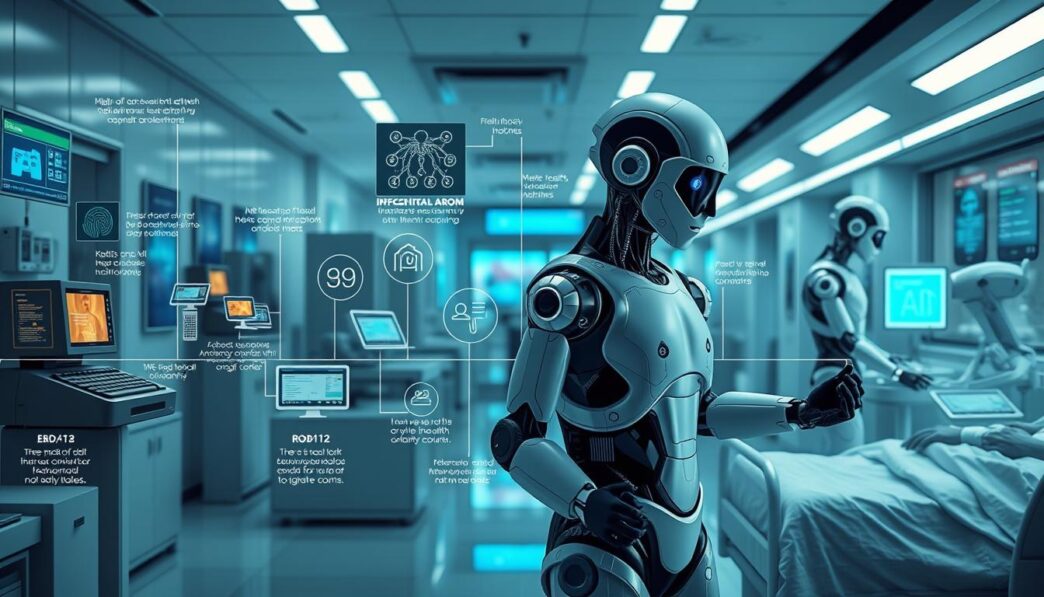AI has changed healthcare since the mid-20th century. It started in the 1950s and 60s, using computing to solve medical problems12. Then, in the 1970s, systems like MYCIN showed how AI could make complex decisions like humans1. By the 1980s and 90s, AI improved medical imaging with CAD systems. This helped find diseases early by making mammograms and radiographs clearer1.
When the 21st century began, big projects like the Human Genome Project in 2003 made AI even more important1. It started to help with understanding genes, and technologies like machine learning made healthcare better1. AI is now getting better at predicting diseases, making diagnoses more accurate, and giving patients personalized care. We are close to a future where AI will make patient care much better and create personalized health plans3.
AI can learn a lot from the health data we have. To find out more about how AI is changing healthcare, check this comprehensive resource1.
Key Takeaways
- The journey of AI in healthcare, evolving from early computational experiments to advanced diagnostic tools, shapes modern medicine.
- Expert systems in the 1970s, like MYCIN, were keystones in demonstrating AI’s capacity for diagnostics and therapeutic advice1.
- Critical advancements in medical imaging, inaugurated by CAD in the 1980s and 90s, revolutionized disease detection and diagnosis1.
- With AI’s ingress into genomics post-2003, personalized medicine has taken significant strides towards precise, individualized patient care1.
- Machine learning and deep learning now drive the ongoing evolution of AI in healthcare, augmenting every aspect from treatment plans to drug discovery1.
- The anticipated future of AI, replete with virtual care and advanced healthcare education, will continue to reshape the medical field3.
Early Beginnings: Roots of AI in Healthcare
The journey of AI origins in medicine began in the mid-20th century. This period was crucial for merging complex algorithms with medical diagnostics. It paved the way for computational medicine.
The Dawn of Computational Medicine in the Mid-20th Century
In 1954, Nash F.A. introduced “Differential Diagnosis”, enhancing medical analysis. Soon after, Ledley and Lusted worked on the “Reasoning Foundations of Medical Diagnosis” in 19594. Their efforts were key in advancing computational medicine.
Warner’s mathematical methods, introduced in 1961, improved diagnosing heart diseases4. These developments sparked greater interest in AI. They aimed to increase diagnostic precision.
The Formative Years: Dendral and Expert Systems
The Dendral project started in the early 1960s. It was crucial for using AI in analyzing organic molecules. This project proved AI’s value in scientific research. It also helped develop expert systems in medicine, like the MYCIN system5.
In the early 1970s, MYCIN was created to figure out bacterial infections and suggest antibiotics. It showed how AI can replicate human decision-making in healthcare5.
Another milestone was INTERNIST-1, made in 1971. It was the world’s first artificial medical consultant5. These advances laid the foundation for AI in today’s medical world. They were critical in the progress of digital medicine.
For more info on AI in healthcare, check out this article on the evolution.
| Year | Development | Impact |
|---|---|---|
| 1961 | Mathematical models by Warner and colleagues | Improved diagnostics for heart diseases4 |
| 1971 | Creation of INTERNIST-1 | Introduced AI to medical consulting5 |
| 1970s | MYCIN developed | Enhanced infection diagnosis and care5 |
AI’s early use in healthcare transformed diagnostics and treatments. It also set the stage for future growth in computational medicine and medical expert systems.
The Pivotal Years: Radiology and Computer-Aided Detection
The use of AI in radiology brought big changes, especially through computer-aided detection. It marked a new era in finding and managing diseases. Thanks to things like digital mammography, doctors could spot diseases earlier and manage them better.
Revolutionizing Imaging: AI’s Entry into Radiological Practices
Starting in the early 1980s, AI began to change radiology. This was because of a need for faster, more precise diagnoses. AI could look through lots of images quickly and accurately. This made diagnosing diseases faster and more correct6.
Demystifying Mammography: Milestones in Early Disease Detection
Digital mammography, with AI’s help, became key in battling breast cancer. It let doctors find cancer early, sometimes before any symptoms showed up. Analyzing tumors without surgery became a major part of treating patients. This helped in choosing the best treatment and increased chances of survival76.

| Year | Advancement in AI | Impact on Medical Imaging |
|---|---|---|
| 2017 | Introduction of predictive radiogenomics modeling | Enhanced precision in lung cancer treatment planning7. |
| 2018 | Big data and AI integration in radiology | Broadened capacity for data-driven diagnostics and personalized medicine7. |
| 2020 | Deep learning applications in diagnostic imaging | Improved triaging and preliminary assessments in radiographic exams6. |
| 2022 | Expansion in AI research for radiological applications | Further enhancements in safety, workflow, and educational standards in radiology6. |
This important time in medical imaging not only laid the groundwork for new breakthroughs but also changed how we see radiology in healthcare. The partnership between classic radiology methods and new AI technologies is making medical diagnostics even better.
Deciphering Genomes: AI’s Leap into Genomic Medicine
AI has fundamentally changed genomic medicine, making personalized treatments more effective. The Human Genome Project’s completion in 2003 started this new phase. It provided a blueprint for applying AI in genetics8. AI now plays a key role in linking genes to diseases, improving how well treatments are tailored to individuals.
By 2004, over 6,000 genes were mapped, enhancing AI’s data analysis capabilities8. Projects like DeepMind’s AlphaMissense showcase these advances. They offer insights into missense mutations affecting millions of variants, based on models like AlphaFold9.
AI-driven genomics is not just about collecting data but also interpreting it effectively. This has led to better diagnoses and treatment plans. Advances in CRISPR technology highlight AI’s role in improving gene-editing accuracy10.
The surge in genetic data has made sophisticated AI algorithms essential. These tools convert vast data into helpful medical advice. They are crucial for the development of personalized medicine10.
The fusion of AI and genetic research promises to revolutionize genomic medicine. It aims at early disease detection and improved healthcare worldwide. As AI merges with genetics, the prospect for revolutionary healthcare advances is unlimited.
AI’s Modern Marvels: Machine Learning and Deep Learning in Healthcare
Machine learning and deep learning are changing healthcare immensely. They bring much more precision and efficiency to clinical work and patient care. Doctors can now get better at diagnosing and creating personal treatments, thanks to AI11. AI lets doctors diagnose illness faster and more accurately from lots of data. This cuts down mistakes and greatly helps patients get better.
Pattern Recognition and Predictive Analytics: A New Era in Medicine
Predictive analytics changes how doctors care for patients. They can now predict health risks and plan treatments that fit each person11. Deep learning makes understanding X-rays and MRIs easier, boosting diagnosis and treatments. AI also helps in checking on patients remotely, catching problems early for better treatment success11. This highlights how key AI is in making healthcare more proactive and personal.
From Drug Discovery to Treatment Plans: AI’s Broadening Scope
AI is making drug discovery faster by analyzing molecular and clinical data11. It allows for treatments that are more tailored to the patient, by looking at genes and biomarkers11. Even though there are concerns over data privacy and algorithm transparency, AI in healthcare aims to improve patient health and life quality11. For more on AI, especially in surgery, check this in-depth review.




















